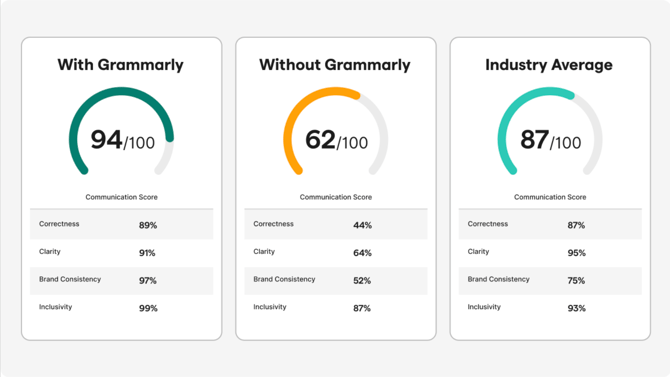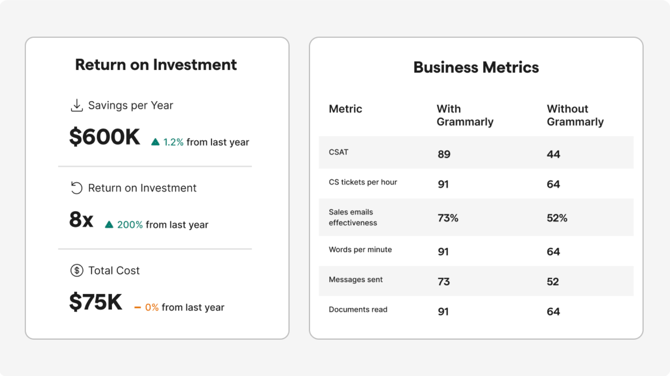In 2019, there were only 21 products in the AI Writing Assistant market.
Today, that software category is exploding, with more than 600 solutions competing for market share as part of the generative AI revolution.
As G2’s CMO, I’m always watching how companies navigate crowded software categories and maintain their competitive edge. That’s why I was excited to sit down with my friend Lena Waters, CMO at Grammarly, during our G2 Reach event to discuss how Grammarly continues to lead an increasingly competitive category.
Here are some of my key takeaways from our talk.
Going beyond typos and grammar checks
One of the first things Lena touched on was how Grammarly has successfully evolved its brand perception in the market. While many originally used Grammarly as a spelling and grammar check tool, the company has intentionally and successfully repositioned itself as a writing partner for both personal and professional use.
This requires a delicate balance in messaging: they need to support distinct use cases for both consumers and enterprises while maintaining a unified value proposition that “Grammarly is for work.”
This strategy comes to life in some of Grammarly’s most recent campaigns, featuring ads targeting these two distinct audiences.
Grammarly’s enterprise-focused ads highlight their AI-powered efficiency, citing an impressive statistic that 70,000 teams trust Grammarly in the workplace.
On the flip side, their consumer-focused ad uses a more playful tone to paint a picture of the best-case scenario for individual users: a dreaded meeting transformed into a simple email instead.
Dual-purpose go-to-market
Grammarly’s dual-purpose go-to-market approach is fascinating. The brand has grown—both top-down and bottom-up—by creating value for individual users and delivering benefits for enterprise organizations.
As Lena explained, Grammarly has become one of the most requested tools in the workplace because it helps people “show up as the best version of themselves. Individuals can win with Grammarly, teams can win with Grammarly, and businesses can get the impact that they want.”
As a big fan of Grammarly myself, this really resonates with me. The tool’s seamless integration into users’ daily work makes it invaluable.
That is crucial in an industry where, according to our most recent Buyer Behavior Report, 78% of buyers expect to see ROI within six months of purchase.
At G2 we are looking at utilization rate as one of the most important and newly emerging metrics for measuring ROI—especially when it comes to AI-powered tools.
Measuring what matters
Helping customers prove ROI for AI tools is one of the most common challenges facing brands like Grammarly. To address this challenge, Grammarly also introduced an “effective communication score,” the industry’s first metric that measures whether communication achieves its intended impact and not just technical correctness.
It’s another way Grammarly goes beyond simple grammar checking to provide meaningful insights into how communication directly impacts business outcomes.


Leadership lessons for marketers
When I asked Lena to share advice for other marketing leaders in crowded software categories, she shared her top three, which 100% align with my beliefs as well.
- Ensure company-wide understanding of customer needs. It's not enough for marketing to understand customer needs—every employee needs to grasp what problem you're solving and why your solution is differentiated. This needs to be easily understood and reinforced often.
As Lena explained, part of Grammarly’s unique value proposition is that it not only helps individuals accomplish key outcomes but also helps them show up as the best version of themselves. And when individuals show up as the best version of themselves, teams win, and the business gets the impact they want.
- Avoid "random acts of marketing." Stay disciplined and focused on key integrated moments that build a stronger brand narrative. Sometimes, what you choose not to do is as important as what you do.
- Align user experience with brand promises. The product must deliver on the story you're telling. Marketing can't operate in isolation. It needs to work hand-in-hand with product, innovation, and engineering teams.
Grammarly maintains its leadership position not through flashy marketing alone but through a careful balance of brand awareness, product excellence, and measurable business impact.
As AI continues to become more prominent and new competitors emerge daily, this holistic approach to market leadership offers valuable lessons for any marketing leader looking to stand out in a crowded category.
If you missed my conversation with Lena, you can watch it here on-demand, along with all of this year’s Reach sessions.
 by Rebecca Reynoso
by Rebecca Reynoso
.png) by Shreya Mattoo
by Shreya Mattoo
.png) by Shreya Mattoo
by Shreya Mattoo